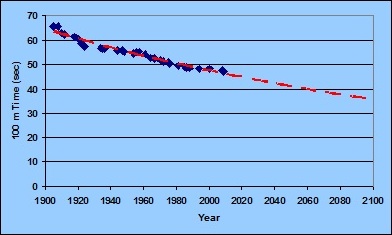The best swimmers in the world are racing at a speed of 2.1 m/sec – certainly not an easy feat. This speed requires a far better than average technique and considerable strength (as well as super conditioning and expert coaching).
A formula (the drag equation) is useful for calculating how strength and technique contribute to speed. When applying this formula, technique is measured by the active drag coefficient (Cd) and strength by hand force. Calculations show that a swimmer with a Cd of .8 (where Cd = 1.0 is average) must generate an average hand force of 40 lbs (180 Newtons) to swim 2.1 m/sec.
Are you strong enough to generate an average force of 40 lbs? Keep in mind that swimmers often waste one-third of the stroke with the arm in a weak position that generates very little force (less than 5 lbs). Typically, a swimmer must be capable of a peak force of 60 to 80 lbs (with each hand) to maintain an average force of 40 lbs.
How effective is your technique? By the way, if your technique “looks good,” that probably only means your Cd is around 1.0. A Cd must be quantitatively measured, and cannot be qualitatively eyeballed.
So, what is necessary to go faster than 2.1 m/sec? Swimmers can work on traditional methods to improve both their strength and technique so that average force is greater than 40 lbs and Cd is less than .8. However, probably the most neglected area for performance improvement is arm coordination.
A .1 sec change in arm coordination can increase the average hand force by almost 7 lbs. Unfortunately, many swimmers practice an antiquated counterproductive arm coordination – catch-up stroke – that results in gaps in propulsion and a lower average force. A more continuous source of propulsion yields a higher average force without having to get stronger!

